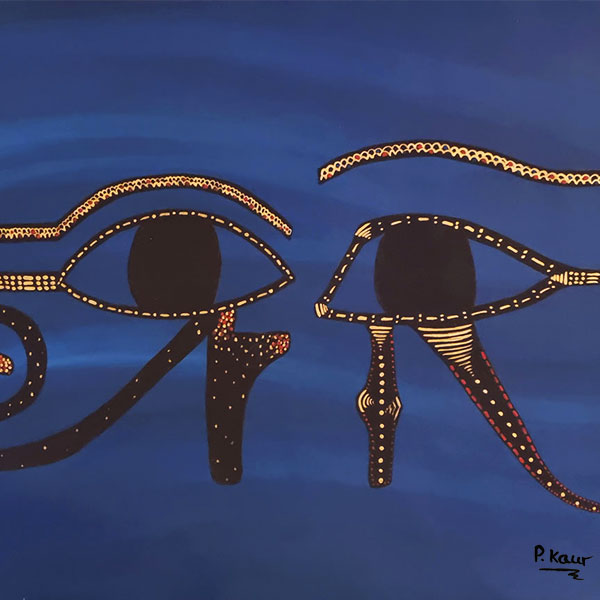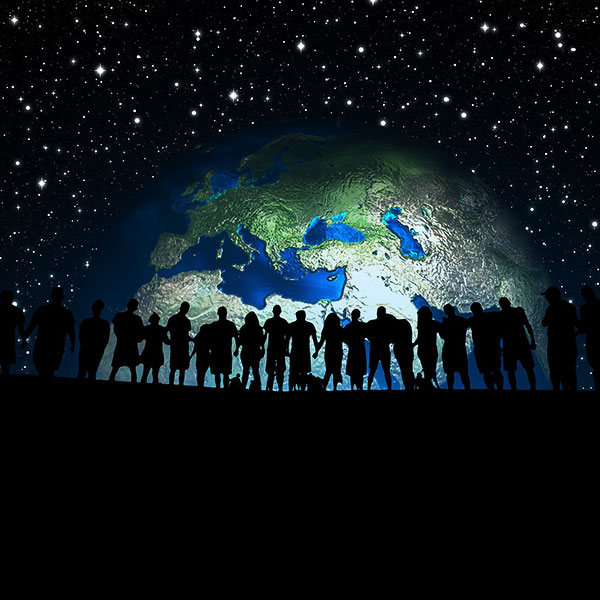Adaption to the environment is the cornerstone of the concept of evolution of life. Organisms have slowly changed in physical form to better suit the environment they find themselves in. On this initial level, there is, without intention I would have thought, a respect for the environment. It is what it is and the organism living in it, extracting from it for its own uses, adapts to the environment and not the other way around. At least that’s the way it has been for a few billion years.
Early organisms
We can see this in early organisms. Single celled organisms evolving from the combinations of chemical elements, producing emergent properties that lead to interesting cellular behaviour. Carbon is one of the key ingredients to life in the sense of living organisms. It also produces graphite and diamond which in itself, it just amazing. The sheer flexibility and emergent properties that occur simply by the structure and amount of this one chemical element.
Organisms first adapted to an atmosphere that was heavy in greenhouse gases, methane and carbon dioxide. Organisms then adapted to an atmosphere that was full of free oxygen. For this adaptation to happen, the previous organisms had to die off, they couldn’t continue in this atmosphere as they weren’t adapted for it, their way of life had to literally die and be gone forever. They couldn’t adapt on a physical to suit the new environment quick enough.
Life began in the sea. There were various global events that caused changes in the sea. Some areas would become anaerobic, that is depleted of oxygen for various reasons, creating stagnant oceans. Sometimes the entire globe would be covered in ice and so organisms had to either find areas of ocean where the ice was thin and they could get some sunlight, or just descend to the depths and evolve into new ways of living, abandoning the old ones.
The single celled organisms went from cloning exactly to reproduce, to sexual reproduction. That is bringing together different compatible cells, to form new cells with DNA from both parents, leading to a whole new level of complexity and emergent properties. The ability to adapt to new environments just got that much easier and yet harder. Cloned cells would have found it difficult adapting to new environments, if they were cloned exactly the same, with exactly the same behaviours, how would this work if for some reason, the ocean acidity changed due to other events. Sexual reproduction proved immensely successful in the journey of adapting to the environment with respect to the environment. It was locked into place.
Cambrian explosion
538 million years ago begins the current eon of earth’s history, the Phanerozoic. The eon of multi-cellular life. Organisms spread out throughout the oceans. The landmasses that developed in the previous eons would have created new niches for organisms. Each part of the world has its own environment, its own temperatures, and its own composition. The spreading of organisms throughout the seas adapting to different environments, is something that happens with every new radiation of speciation.
By this time, the different types of organisms (plants, fungi, animals, bacteria) were quite distinct with their own methods of extracting energy, absorbing nutrients, reproducing and excreting waste. This is what defines them in the taxonomy classifications. In the animal kingdom, organisms evolved to eat other organisms as a more effective way of extracting energy for themselves.
As animals evolved to move around, as opposed to plants or fungi that live relatively stationary lives, the options opened up of what to eat and how. Shells would form from the calcium on the sea floor to protect organisms. They would evolve to be the first skeletons, external and then internal. This would increase prey protection and predator ability. As organisms began to increase in number, complexity and niches throughout the globe, they adapt not only to the changes in the physical environment, but in response to other organisms. This requires a certain amount of awareness for the organism itself. Or consciousness.
Life develops
As the years roll on in the current eon and after the Cambrian explosion, we can see life diversifying and adapting to new environments in rapid speed. The species of organisms increase as well as the number of individuals within a species, depending on the environmental balance required. The adaptions get locked in and enable them to reproduce with more success of surviving.
We get the age of fish in the Devonian period (419 million to 358 million years ago), going from jawless, to jawed, to cartilaginous, to bony, eventually developing the skeleton. Then the lobe finned fish get into shallow waters, evolve into tetrapods (organisms with four limbs), adapt to the drier lands with tougher skin, different breathing apparatus, harder skin on the feet to walk and laying young in hard shelled eggs.
Amphibians are here, dominating the carboniferous period (358 million to 298 million years ago). At the same time, plants have come onto land, again diversifying and evolving to the physical conditions of the drier landscape compared to the seas. It is thought that the first forests covered the landmass, and the trees themselves were huge in size. This is the basis for the coal deposits we are using today.
As more organisms populate the land, plants, fungi and animals, they have to adapt again not just to the change of environment from water to land, but to each other. This constant balancing act is fundamental to the evolution of life as we know today.
We then get the age of reptiles that dominate the Mesozoic era which encompasses the Triassic, Jurassic and Cretaceous periods, all covering the years of 252 million years ago to 66 million years ago. Dinosaurs developed better breathing systems as during this time, oxygen levels on earth were lower than they are today. Their eggs now are laid on land rather than in water as it is for amphibians. Land animals did become immense in size compared to us today.
It was during this time that plants evolved into flowering plants, giving rise to not just flowers, but edible crops that we know of today like fruits and wheat, anything that is derived from seeds. This again would increase the number of organisms and create more necessary adaptions. As new food sources develop, organisms then develop new eating methodologies to accommodate for the changes in environment. The food sources would provide more nutrients for organisms, perhaps changing them in other physical ways which then other organisms would respond to and adapt accordingly.
Humans adapting
Our adaptation story begins similar to other organisms, to adapt to the changing environment we find ourselves in and to other organisms in that environment. Some of the adaptions that eventually lead to Homo sapiens as we are today, are not that remarkable in of themselves.
We tend to think of ourselves as amazing things, with these unique adaptations that have allowed us to create the life we have today. In reality, we are not that dissimilar to other organisms except in a handful of ways. Even those few ways, while it has enabled us to do things that other organisms have not been able to, it doesn’t necessarily make us superior and more important than other organisms. It’s that superiority that has lead humanity into many of our current problems in society.
We evolved from walking on all fours to two. The reason for this isn’t entirely clear, could be so we can see better across the savannah, run in a different way, adapt to grass land. Who knows? This actually caused a lot of problems giving birth for women, due to the narrow hips of walking upright. We have grasping hands and fingers, but not great grasping toes. We have stereoscopic vision as do other primates. We have larger brains relative to body size, other primates do though not as big and the Neanderthals had bigger brains than us. Our DNA is more than 60 percent similar to that of a banana. And 96 percent similar to chimpanzees. We have tools though we were not the first species to use tools, meaning to take something in its natural form and purposefully change its purpose and use. We are not the first species to be creative and innovative, this occurred in earlier humans. We are not the only species to speak, other animals have their own languages as well. Socially, we display similar traits to other primates in our social structures, hierarchies, mating rituals and trusting members of our tribe.
What puts us apart is our ability to adapt our environment to our perceived needs of the time. Our linguistic abilities. Our ability to believe in the abstract. Our ability to pass on information to the next generation. Our curiosity and creativity.
We have become conscious and aware of what we need to survive and live, and we became aware that we can manipulate and create different ways of getting our needs met from our environment. Somewhere along the way, we became aware that we can do more and create more in order to have better versions of the things we needed like plentiful food, better homes and clothing. We became aware that the environment around us provides ample opportunity to improve our own lives, if we use it and extract from it in particular ways. Creating better ways of living and being is fundamental to being a Homo sapien. Seemingly previous species of the Homo genus made tools which changed very little in thousands and millions of years.
Though it is evident that we are potentially the first species in the tree of evolution to have the level of awareness and consciousness that we do, there is still very far to go in terms of awareness and consciousness of who we are and what we are doing. It is possible that other species of the Homo genus had a similar level of consciousness and awareness, it just took a different path. Even within Homo sapiens, we evolved around 250,000 – 300,000 years ago but it wasn’t really until 100,000 years ago we find evidence of conscious behaviour taking new turns. And then again around 50,000 years ago, new levels are revealed.
On an individual level in today’s society, it is even hard to adapt ourselves to different environments and to new information. Many of us stick steadfast to our opinions and beliefs that have been formed earlier on in our lives. This informs our identity so anything new whether its information or a new environment, is a threat to our identity. We may be aware and conscious, but how aware are we really? The plethora of religious teachings and philosophy does demonstrate that humanity isn’t as aware of ourselves as we think we are. A handful of people have come along in each generation to demonstrate this point to us, to give us some wisdom adapted to the people of that time and yet, many points of wisdom transcend time and cultures.
We are sometimes that unaware of ourselves, that when it comes to new environments and situations in life, we are ill adapted. We carry with us the burdens and pains of our childhood into adulthood. We behave in certain ways that are no longer suitable for current environments and situations. Of course this isn’t a blanket rule for all Homo sapiens, but I am surprised to discover how widespread it actually is.
Our species and some of the other species of Homo, have added new meaning to the concept of evolution and adaptation. We may continue to evolve on a genetic level, after all the enzyme to process milk evolved with agriculture only 10,000 years or so. However we have not adapted to our environment, we have adapted our environment for our needs, not really fully understanding what they are. Therefore we have created an environment that is ill adapted to our body plan and brain structure. Humanity is suffering on many levels. The environment we have adapted is also ill adapted for other species on this planet. Again, they are suffering on many levels.
Humanity moving forward
Today, humanity has more awareness and information than ever before. The information age is less than a hundred years old. We are still blissfully ignorant of many things, however with the information age, we can begin to have the knowledge and finally some understanding of what we are in terms of body plan and brain structure. We can begin to appreciate that the world we have adapted for our apparent needs, is not serving our actual needs at all. As our knowledge and understanding grows, we can only hope that it will affect humanity in such a way that we can re-adapt the environment to suit our actual needs and the needs of the species we share the environment with.
We can hopefully evolve out of the reward circuit system we developed. The reward circuit evolved to give us motivation to seek out those things in our environment that were essential for survival and reproduction. It is a system that numbs pleasure responses giving us further motivation to seek out these things. This would include water sources; high sugar salt fatty foods as they provided energy; pleasurable social interactions as this increased the chances of reproduction; the thrill of hunting and killing animals to ensure we keep eating; the pleasure of being in power, to ensure the tribe sticks together under leadership, survives and fights other tribes for territory, food and shelter. The world today is over stimulating for our bodies and our brains. Not just with food but all manner of things. As a result, we suffer. And continue to try to find ways to ease the suffering with new innovations and advice.
If we don’t re-adapt our environment, we perish. We’ll leave behind a very small number of humans who will maybe evolve into a new species, capable of seeing beyond short term pleasures, capable of creating a food industry that doesn’t push nature to the brink of collapse, evolve a hierarchy system of power that isn’t so abusive, devalue the importance of money, create an everyday life for humans that works with our body plans and brain structures and doesn’t over-stimulate it and above all, re-adapt the environment for other species to thrive once more.





